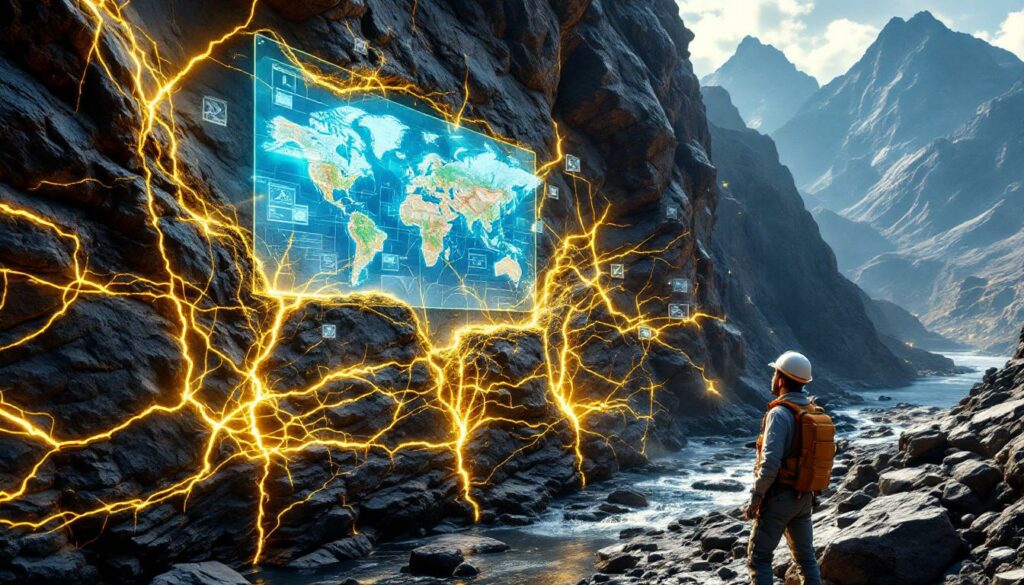What Makes Gold a Geological Treasure?
Gold has captivated humanity for millennia, standing as one of Earth's most coveted elements. Beyond its economic and cultural significance, gold represents a fascinating geological narrative that spans billions of years of planetary evolution. Its unique properties and distribution patterns make it both a scientific puzzle and an economic prize.
The Ancient Allure of Gold
Gold's extraordinary physical properties have made it an object of desire across civilizations and time periods. Its distinctive yellow luster, exceptional malleability, and remarkable resistance to oxidation and corrosion set it apart from nearly all other naturally occurring elements.
Historical fascination with gold dates back more than 6,000 years, with archaeological evidence from ancient Egypt showing sophisticated goldsmithing by 2600 BCE. The metal's indestructibility meant that artifacts crafted millennia ago remain virtually unchanged today.
"Gold's inertness allows it to survive billions of years of geological recycling, concentrating in specific tectonic settings." – David Rickard, geochemist
This permanence explains why gold became synonymous with wealth, power, and divinity across diverse cultures:
- Egyptian pharaohs were entombed with elaborate gold artifacts, including Tutankhamun's famous burial mask (1323 BCE)
- Chinese emperors considered gold a symbol of heavenly power
- Pre-Columbian civilizations crafted intricate ceremonial objects
- European monarchies based entire economic systems on gold reserves
While gold's cultural significance remains strong, modern applications have expanded dramatically. Today, approximately 8% of annual gold production serves industrial purposes, particularly in electronics where its non-corrosive properties and exceptional conductivity make it irreplaceable for critical components.
The Geological Significance of Gold
Gold's distribution throughout Earth's crust follows specific geological patterns rather than random scattering. With a crustal abundance of merely 0.0031 parts per million (significantly rarer than copper at 0.0068 ppm), gold concentrates along predictable structures that geologists have learned to identify.
These patterns are encoded in:
- Rock types – particularly metamorphosed volcanic sequences
- Mineral assemblages – including sulfide minerals like pyrite
- Structural features – especially fault zones and shear belts
- Fluid pathways – where hydrothermal solutions once flowed
For geologists, interpreting these patterns is akin to reading a complex manuscript written in the language of minerals, textures, and structures. The most economically significant gold deposits typically form along cratonic margins through lithosphere delamination processes, creating distinct metallogenic provinces worldwide.
By understanding these geological signatures, exploration teams can significantly narrow their search parameters, focusing on regions with favorable characteristics instead of searching blindly across vast terrains.
How Does Gold Form Deep Within the Earth?
The journey of gold from its cosmic origins to mineable deposits involves complex geological processes operating across billions of years. Understanding these mechanisms provides critical insights for geological gold exploration seeking new discoveries.
Origins of Gold Deposits
Gold's story begins in the cosmos. The element formed through nuclear fusion in neutron star collisions and stellar explosions before being incorporated into our solar system. During Earth's formation approximately 4.5 billion years ago, most gold sank toward the planet's core due to its affinity for iron.
The gold accessible today arrived primarily through the Late Heavy Bombardment period (4.1-3.8 billion years ago), when meteorites delivered an estimated 20 billion tons of gold to Earth's surface. This "late veneer" theory explains why gold is more abundant in Earth's crust than would be expected from core formation processes alone.
Once present in the crust, gold requires specific mobilization and concentration mechanisms to form economically viable deposits:
- Hydrothermal circulation – Superheated fluids (200°C-400°C) with high salinity (>10 wt.% NaCl equivalent) serve as the primary transport mechanism
- Magmatic processes – Intrusive bodies provide heat and sometimes gold directly
- Metamorphic reactions – Release gold from existing rocks during mountain-building events
Without these concentration processes, gold would remain too dispersed for practical recovery, highlighting why productive deposits form only under specific geological conditions.
The Mechanics of Gold Deposition
Gold transport and deposition involve sophisticated geochemical processes operating under extreme conditions. These processes create the concentrated deposits that support mining operations worldwide.
The typical sequence includes:
- Source rock interaction – Hydrothermal fluids originating in magmatic chambers extract gold and other elements
- Transport phase – Gold moves as complex ions (typically with sulfur or chlorine) through fracture networks
- Deposition triggers – Specific environmental changes cause gold precipitation:
- Temperature decrease below critical thresholds
- Pressure drops below 1.5 kbar
- pH shifts due to wall-rock interaction
- Redox state changes (especially reduction)
The presence of indicator minerals often signals potential gold mineralization. These include:
- Pyrite (FeS₂) – Often hosts "invisible gold" via lattice substitution
- Galena (PbS) – Frequently associated with gold-bearing systems
- Chalcopyrite (CuFeS₂) – Common in porphyry-related gold deposits
- Arsenopyrite (FeAsS) – Strongly correlated with many gold occurrences
These minerals provide valuable exploration clues, as they're typically more abundant and easier to detect than gold itself.
Major Gold-Bearing Geological Structures
Certain geological environments consistently host significant gold deposits. These "gold-friendly" settings share characteristics that facilitate the concentration processes described above.
Orogenic belts represent one of the most productive environments for gold formation. These mountain-building zones, where tectonic plates collide, create ideal conditions for gold mobilization and trap formation. The intense pressure, heat, and fluid movement along these collision margins drive gold-concentrating processes.
Notable examples include:
- Yilgarn Craton (Western Australia) – Contains the Super Pit at Kalgoorlie, which has produced over 60 million ounces from 2.8 billion-year-old greenstone sequences
- Abitibi Greenstone Belt (Canada) – Hosts the Timmins district, formed 2.7 billion years ago during the Trans-Hudson orogeny
- Ashanti Belt (Ghana) – Africa's most productive gold region, containing multiple world-class deposits
Understanding these major gold-bearing structures allows companies to focus exploration efforts on regions with similar geological characteristics, significantly improving discovery rates.
Why Are Greenstone Belts Critical for Gold Exploration?
Greenstone belts represent some of Earth's most prolific gold-producing regions, accounting for over 30% of global gold production. These ancient geological formations create ideal conditions for gold concentration and preservation over billions of years.
Anatomy of Ancient Greenstone Formations
Greenstone belts consist primarily of metamorphosed volcanic and sedimentary rocks that formed during Earth's early history. Most economically significant examples date from the Archean Eon (4.0-2.5 billion years ago), though younger belts also exist.
Key characteristics of these formations include:
- Age – Typically exceeding 2.5 billion years (Archean)
- Composition – Dominated by mafic volcanic rocks (basalts) metamorphosed to greenschist facies
- Chemistry – Rich in iron and magnesium minerals
- Structure – Highly deformed through multiple tectonic events
- Metamorphism – Generally amphibolite-facies (450°C-550°C) enabling gold remobilization
These ancient rock sequences have undergone extensive deformation, creating complex networks of faults, shear zones, and fractures that serve as conduits for mineralizing fluids. Their chemistry also provides ideal precipitation environments for gold-bearing solutions.
The Pilbara Craton in Australia exemplifies these characteristics, hosting a mineral endowment exceeding 250 million ounces of gold throughout its ancient greenstone sequences.
Gold Mineralization Patterns in Greenstone Belts
Within greenstone belts, gold mineralization follows recognizable patterns that guide exploration efforts. The most productive deposits typically occur as mineralized quartz veins formed along shear zones or fault planes.
These mineralized structures:
- Range from centimeters to several meters in thickness
- Extend for kilometers along strike and hundreds of meters down-dip
- Contain gold grades typically between 1-5 grams per ton
- Often feature visible gold particles within quartz or associated with sulfide minerals
While these grades might seem modest (1-5 grams represents just 0.0001-0.0005% gold content), the extensive volume of mineralized material makes extraction economically viable, particularly in operations exceeding 5 million ounces at record gold prices above $1,300 per ounce.
The structural complexity of greenstone belts creates numerous potential trap sites for gold deposition. Listric faults within komatiite sequences create dilation zones particularly favorable for quartz-carbonate vein formation. These structural traps represent primary targets for exploration geologists working in greenstone terrain.
How Does Gold Travel Through Geological Time?
Gold's journey from primary deposits to discoverable concentrations spans vast geological timeframes. Understanding these natural concentration mechanisms provides critical insights for exploration and extraction.
The Journey from Primary to Secondary Deposits
After initial deposition in veins or disseminated zones, gold undergoes redistribution through weathering and transport processes. This secondary enrichment creates some of history's most accessible gold discoveries.
The transformation sequence involves:
- Weathering – Chemical and physical breakdown of gold-bearing rocks
- Liberation – Gold particles separate from host minerals
- Transport – Water systems move gold particles based on density and size
- Concentration – Physical sorting concentrates gold in specific environments
Rivers can concentrate gold at levels 1,000 times higher than source rocks through this natural processing, as documented by sedimentologists Slingerland and Smith. This extraordinary enrichment explains why placer deposits have driven many historic gold rushes despite representing secondary concentrations.
Gold's exceptional density (19.3 g/cm³) plays a crucial role in this process. During fluvial transport, gold particles achieve hydraulic equivalence with quartz grains approximately 10mm in diameter, causing them to settle in predictable locations:
- Inside bends of rivers
- Behind large boulders
- Within natural riffle structures
- At the base of waterfalls
- In abandoned river channels
Unlike many metals, gold resists chemical weathering due to its noble metal status. The absence of ionic gold (Au⁺) in typical surface environments prevents dissolution, allowing gold particles to survive multiple erosion-transport-deposition cycles virtually unchanged.
Historical Significance of Placer Gold
Placer deposits have driven many of history's most significant gold discoveries, often leading prospectors to primary source deposits. Their accessibility with simple tools made them ideal targets for early miners.
The California Gold Rush (1848-1855) exemplifies this pattern. The discovery of placer gold at Sutter's Mill triggered a migration that ultimately yielded 12 million ounces from stream deposits. Similar patterns emerged during:
- Klondike Gold Rush (1896-1899)
- Australian rushes (1850s)
- Brazilian discoveries (18th century)
- Modern Alaskan operations
Traditional placer mining employed simple mechanical separation techniques based on gold's high density:
- Panning – Manual swirling separates heavy gold from lighter sediments
- Sluice boxes – Artificial riffles trap gold as water carries sediment downstream
- Rocker boxes – Combine washing and classification for increased efficiency
Modern placer operations utilize sophisticated technologies while maintaining the same physical principles:
- Drone-mounted LiDAR identifies paleochannels in regions like the Yukon
- Ground-penetrating radar detects buried ancient stream courses
- Heavy equipment processes large volumes efficiently
- Environmental safeguards minimize ecosystem impacts
Understanding placer formation processes remains relevant for contemporary exploration, as ancient placer deposits now buried and lithified (fossil placers) represent significant gold resources worldwide.
What Technologies Drive Modern Gold Exploration?
Contemporary gold exploration integrates traditional geological knowledge with cutting-edge technologies. This multi-disciplinary approach dramatically improves discovery rates while reducing environmental impacts.
Integrated Multi-Disciplinary Approaches
Modern exploration programs combine complementary techniques to identify potential deposits with unprecedented precision:
Remote sensing technologies provide the foundation for initial assessment:
- Satellite multispectral imagery identifies alteration patterns
- LiDAR mapping reveals subtle structural lineaments
- Hyperspectral sensors detect specific mineral signatures
- Synthetic aperture radar penetrates vegetation in tropical regions
These tools generate preliminary targets for follow-up investigation using geophysical methods:
- Induced polarization (IP) surveys measure chargeability anomalies from sulfide-rich veins (targeting readings >30 mV/V)
- Resistivity measurements identify silicified zones and clay alteration
- Magnetic surveys detect magnetite destruction in hydrothermal systems
- Gravity mapping identifies density contrasts associated with intrusions
The integration of these datasets creates a three-dimensional picture of subsurface features, significantly narrowing search parameters before expensive drilling begins.
Geochemical Detection Methods
Geochemical techniques have revolutionized gold exploration through dramatically improved detection capabilities. Modern laboratories can identify gold at concentrations as low as 0.1 parts per billion using laser ablation ICP-MS technology, enabling detection of subtle anomalies invisible to previous generations.
Sampling programs typically target:
- Soil horizons – Systematic grid sampling of B-horizon soils
- Stream sediments – Targeting fine fractions in active drainages
- Rock samples – Both outcrop and float material
- Vegetation – Biogeochemical sampling in covered terrains
Rather than focusing exclusively on gold, modern geochemists analyze for pathfinder elements that create larger, more detectable halos around mineralization:
- Arsenic (As) – Often forms extensive dispersion patterns
- Antimony (Sb) – Strongly associated with epithermal systems
- Bismuth (Bi) – Common in intrusion-related gold
- Mercury (Hg) – Volatile element creating broad anomalies
These pathfinder elements can extend 300 meters beyond actual gold mineralization in lateritic terrains, creating larger target areas for follow-up work.
Advanced Modeling and Drilling Techniques
Once promising targets are identified, advanced modeling and drilling technologies allow precise testing and evaluation:
3D visualization software integrates all available data into comprehensive models:
- Leapfrog Geo® and similar platforms create dynamic geological models
- Machine learning algorithms identify patterns invisible to human analysts
- Artificial neural networks predict drill targets with up to 85% precision
These sophisticated models guide drilling programs using technologies like:
- Directional drilling to precisely intersect predicted structures
- Portable XRF for real-time elemental analysis of drill cuttings
- Optical and acoustic televiewer for detailed structural data
- Downhole geophysics to extend information beyond the physical drill hole
Kirkland Lake's Macassa Mine demonstrates the power of these approaches, using Leapfrog modeling to extend gold reserves to depths exceeding 3 kilometers, discovering high-grade zones that previous exploration missed.
Assay results undergo rigorous quality control protocols, with certified reference materials ensuring accurate gold determination at ever-lower detection limits.
What Challenges Face Gold Exploration Today?
Despite technological advances, mineral exploration importance for gold faces significant challenges that impact discovery rates, development timelines, and project economics. Understanding these hurdles is essential for industry participants and investors.
Economic and Technical Hurdles
The "low-hanging fruit" of easily discovered gold deposits has largely been harvested, forcing exploration into more challenging domains:
Depth challenges increasingly dominate exploration:
- Deposits at >500m depth require costlier drilling programs
- Geophysical methods lose resolution with increasing depth
- Infrastructure costs escalate dramatically for underground operations
Grade considerations become increasingly critical:
- Average global discovery grades have declined ~30% over two decades
- Lower grades require larger operations to achieve economies of scale
- Processing costs increase for complex refractory ores
Infrastructure requirements present major hurdles in remote regions:
- Power generation and transmission
- Water access and management
- Transportation networks
- Skilled workforce availability
Market volatility complicates investment decisions:
- Exploration funding fluctuates with gold price forecast
- Long lead times (7-10 years) from discovery to production create timing risks
- Capital intensity has increased substantially for major projects
These economic realities have driven consolidation within the industry, with major producers acquiring junior companies that make significant discoveries rather than developing their own exploration pipelines.
Environmental and Regulatory Considerations
Environmental protection has become a central consideration in modern exploration and development:
Water resource protection represents a primary concern:
- Baseline studies must establish pre-exploration conditions
Ready to Spot the Next Golden Opportunity?
Discover potentially significant ASX gold mining announcements before the market reacts with Discovery Alert's proprietary Discovery IQ model, delivering real-time insights into actionable opportunities. Explore why major mineral discoveries can lead to substantial market returns by visiting Discovery Alert's dedicated discoveries page.




